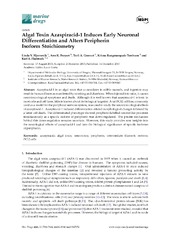Algal toxin azaspiracid-1 induces early neuronal differentiation and alters peripherin isoform stoichiometry
Hjørnevik, Linda Veka; Frøyset, Ann Kristin; Grønset, Toril Anne; Rungruangsak-Torrissen, Krisna; Fladmark, Kari Espolin
Peer reviewed, Journal article
Published version

Åpne
Permanent lenke
https://hdl.handle.net/1956/12494Utgivelsesdato
2015-12-14Metadata
Vis full innførselSamlinger
Originalversjon
https://doi.org/10.3390/md13127072Sammendrag
Azaspiracid-1 is an algal toxin that accumulates in edible mussels, and ingestion may result in human illness as manifested by vomiting and diarrhoea. When injected into mice, it causes neurotoxicological symptoms and death. Although it is well known that azaspiracid-1 is toxic to most cells and cell lines, little is known about its biological target(s). A rat PC12 cell line, commonly used as a model for the peripheral nervous system, was used to study the neurotoxicological effects of azaspiracid-1. Azaspiracid-1 induced differentiation-related morphological changes followed by a latter cell death. The differentiated phenotype showed peripherin-labelled neurite-like processes simultaneously as a specific isoform of peripherin was down-regulated. The precise mechanism behind this down-regulation remains uncertain. However, this study provides new insights into the neurological effects of azaspiracid-1 and into the biological significance of specific isoforms of peripherin.
